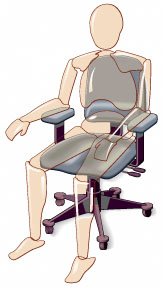| Repetitive stress injuries (RSIs) such as carpal tunnel syndrome and tennis elbow are the number one causes of disability claims, but most people have no idea that RSIs exist or what to do about them. Office workersincluding people who work from their home officesare particularly susceptible to damaging their arms and shoulders because of poor ergonomics in their work-places. We real estate agents may be especially susceptible because we often work in sever allocations, including our brokers' offices where desks and computers are set up for "one size fits all" and at home where we likely have carved out a space for a desk and computer equipment.
Raising a laptop on a platform brings its screen to a comfortable viewing level. Using an external keyboard and mouse helps keep them at comfortable levels as well. (And the platform that raises the laptop doubles as storage for things like staplers and tape).  Be sure to seriously think through the following considerations when setting up your home office: Correct body posture: Correct posture is very important, as incorrect posture leads to extra strain on the body, which leads to injuries that can limit or destroy your ability to type, write, drive, or even brush your teeth. You should sit in "good table manners" posture: back straight, arms at your side, forearms and hands parallel to the floor, thighs parallel to the floor, lower legs straight down (knees at a 90-degree angle), and feet flat on the floor. Adjust the height of your chair and desk or table to ensure this posture. (You might feel uncomfortable at first, but after you let your body adjust for a fewdays, the potentially harmful leaning-forward posture most of us have will instead feel wrong.) You might want to get a chair that lets you adjust the height of the arm rests and distance from the seat, seat height and tilt, seat back angle, and lumbar support. Correct head posture: When working on the computer, you should face straight ahead and not angle your neck down or up to get a better view of the screen. If you draw an imaginary line horizontally a third of the way down from the top of your screen, that line should be at the same elevation as your eyes when looking straight ahead. You might need to raise your monitor to make this work correctly. If you use your laptop's screen, consider raising the entire laptop and plugging in a separate keyboard and mouse so you can type easily without craning your neck to see what you are doing.
Good posture is essential for avoiding repetitive stress injuries. Try sitting in the "good table manners" posture shown in the screenshot to minimize stress on your body.  Good lighting: You need to have sufficient light so you are not straining to see. Ideally, the light is indirect, coming through a translucent window shade, for example, or from an over headlight with a diffuser such as a nontransparent glass globe or plate. You do not want light shining directly on your monitor, because that causes glare that in turn results in eye strain. Tools within reach: Make sure the tools you use regularly are within easy reach, or that you can easily move them into reach while working.
Arrange frequently used items in your workspace so they are within easy reach to minimize arm strain. Also, make sure your monitor is at eye level, so you don't strain your neck. "Eye level" means just that: if you're looking straight ahead, your eyes should be level with an imaginary line a third of the way down from the top of the screen.   CD Resource: A PDF version of the defining article on how to avoid RSIs, "Safer Computing" by Dr. Franklin Tessler, a former colleague of mine, from the December 1994 issue of Macworld. The article's recommendations remain as valid today as they were when it was first published, and they apply to Windows as easily as to the Macintosh. CD Resource: A PDF version of the defining article on how to avoid RSIs, "Safer Computing" by Dr. Franklin Tessler, a former colleague of mine, from the December 1994 issue of Macworld. The article's recommendations remain as valid today as they were when it was first published, and they apply to Windows as easily as to the Macintosh.
|


